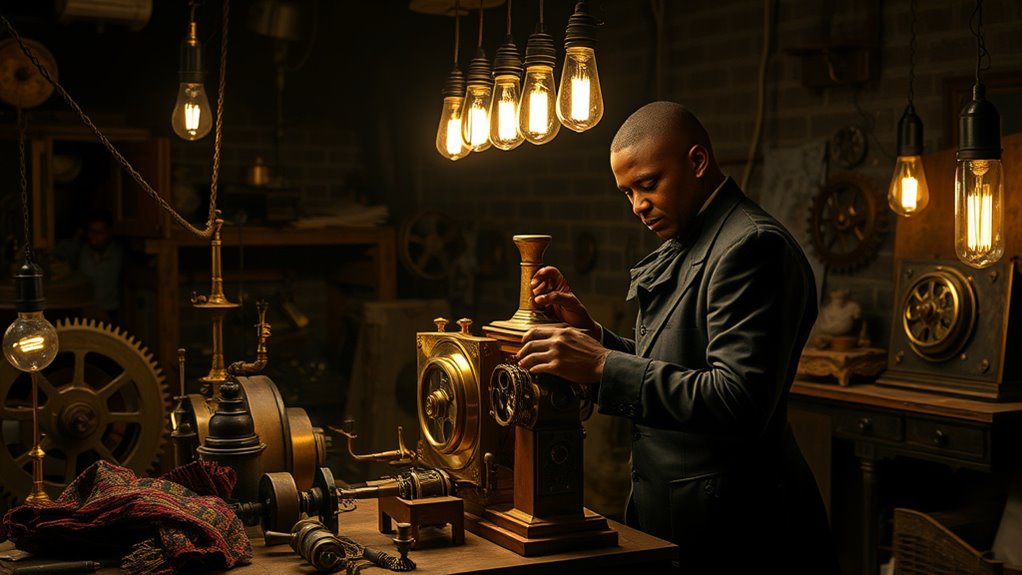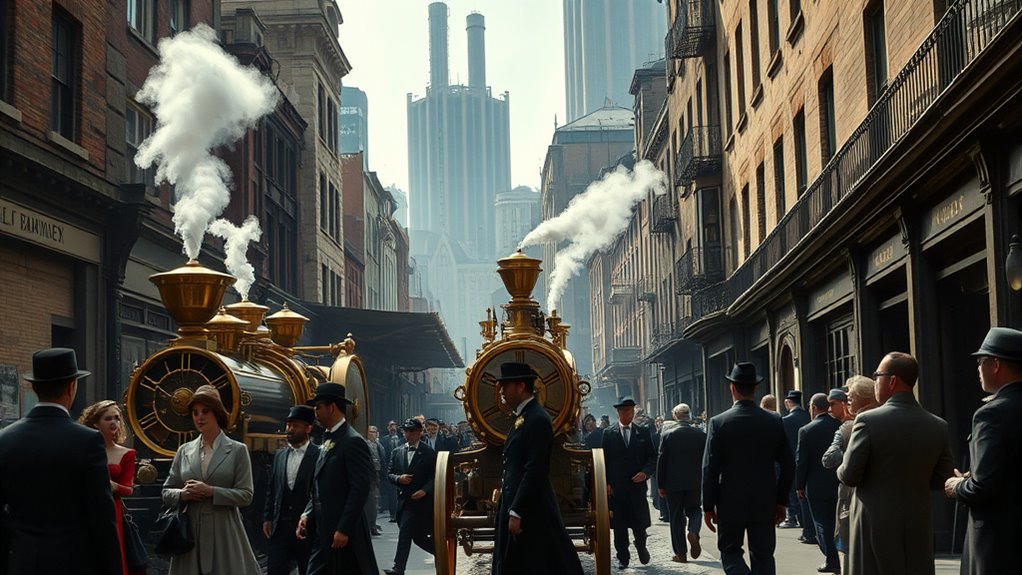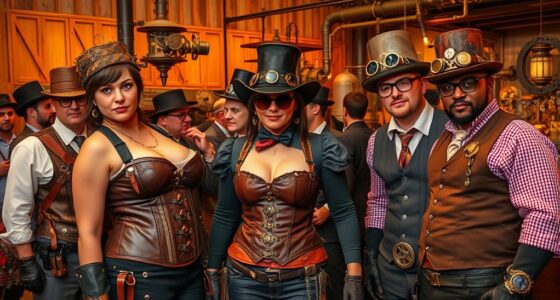Steampunk serves as a powerful critique of societal norms, especially Victorian influences. It challenges class divisions, exposing the gap between elite luxury and working-class struggles. Gender roles are reexamined, showcasing strong female characters defying expectations. The genre explores the implications of technological progress, questioning the ethics of consumerism and the impact on economic disparities. Through alternative histories, it amplifies marginalized voices, pushing you to reflect on contemporary issues. There’s much more to uncover about its societal insights.
Key Takeaways
- Steampunk critiques social stratification, highlighting the stark contrast between elite luxury and the struggles of the working class during the Industrial Revolution.
- The genre reimagines history through diverse perspectives, challenging Eurocentric narratives and amplifying marginalized voices, particularly in the context of race and gender.
- Technological advancements in steampunk narratives reflect contemporary issues, such as the digital divide and automation’s impact on employment and economic disparities.
- Steampunk features strong female characters defying Victorian gender norms, promoting discussions on identity fluidity and the societal structures affecting individual lives.
- The genre encourages a DIY ethos, critiquing consumerism and promoting sustainable practices while inviting reflection on ethics and economic inequality in society.
The Critique of Victorian Norms

While steampunk often romanticizes the Victorian era’s aesthetics, it simultaneously critiques the rigid social stratification that defined the time.
The genre exposes the stark contrast between the luxurious lives of the elite and the struggles of the working class, shedding light on the exploitation by powerful industrialists. This exploitation mirrors the psychological impact of monster lore, where fears of the unknown often reflect societal anxieties. Additionally, the emotional neglect faced by the lower classes can be likened to the disregard shown by those in power towards the vulnerable. The consequences of childhood trauma experienced by the working class highlight the long-term effects of neglect on individuals and society as a whole. A significant factor in this exploitation is the lack of financial literacy, which can leave individuals vulnerable to economic exploitation.
You’ll notice that steampunk characters frequently embody non-conformist ideals, challenging societal norms and oppressive systems.
As the narrative unfolds, you see how industrialization transforms society, yet also creates deep social inequalities.
By integrating fantastical elements with steam-powered technology, steampunk critiques the darker realities of the Victorian era, emphasizing the tensions between progress and exploitation.
This blend of nostalgia and critique invites reflection on contemporary social issues, particularly the impact of industrial technology on societal norms.
Alternative Histories and Marginalized Voices

Steampunk not only critiques Victorian norms but also reimagines history through diverse perspectives that often go unheard.
By setting stories in Middle Eastern or African contexts, you challenge Eurocentric narratives and broaden your understanding of history. Authors alter historical outcomes to comment on contemporary issues, exploring different power dynamics in empires like the British Empire. The emergence of Steamfunk as a subgenre specifically amplifies black voices, enriching the discourse. This genre also reflects the complexities of social constructs such as divorce law in the Philippines, showcasing how personal struggles intersect with societal expectations. In some narratives, characters may experience emotional manipulation that mirrors real-life challenges faced by marginalized groups. Additionally, the exploration of BPD in divorce highlights the emotional struggles that characters endure, reflecting societal challenges around mental health. Furthermore, the incorporation of themes like pet therapy can serve to illustrate how emotional well-being is vital in navigating societal pressures and personal challenges.
Setting narratives in Middle Eastern and African contexts redefines history, challenging Eurocentric perspectives and illuminating contemporary power dynamics.
This genre embraces multicultural narratives, featuring characters from various ethnic backgrounds and identities, including LGBTQ and those with disabilities.
Through inclusive storytelling, steampunk empowers marginalized voices, inviting them to envision worlds where they hold influence.
Engaging with online communities fosters dialogue, allowing these narratives to be celebrated and heard.
Technological Progress and Its Consequences

As technology continues to evolve, it reshapes every aspect of our lives, from how we communicate to the nature of work itself. You can instantly connect with anyone around the globe, but this improvement in communication comes with a digital divide that leaves some behind.
Healthcare has become more accessible through AI-driven diagnostics, yet privacy concerns loom large. While technology fuels economic growth and creates new jobs, automation boosting productivity threatens to displace many workers. The rise of AI-powered virtual assistants further illustrates how technology can enhance productivity but also highlights the need for a balance between efficiency and personal interaction. Additionally, AI technologies in various sectors, such as agriculture, demonstrate both the benefits and challenges posed by rapid advancements in technology. For instance, solar-powered irrigation systems can enhance crop yields and efficiency, showcasing the potential for sustainable energy solutions that improve productivity in agriculture.
As you embrace online education, be aware that dependence on technology can lead to isolation and vulnerability during system failures. The importance of continuous learning becomes evident as we adapt to these rapid changes. Ultimately, while technological progress offers immense benefits, it also introduces complex challenges that society must navigate responsibly.
Gender and Identity in Steampunk

In the vibrant world of steampunk, gender and identity take on dynamic forms, challenging the constraints of traditional roles.
You’ll find women depicted as powerful, independent characters who break free from Victorian expectations, engaging in inventing and air piracy. These narratives often mix ‘hard’ and ‘soft’ imagery, showcasing female figures as both action-oriented and alluring. Steampunk embraces modern perspectives on gender, celebrating fluidity and equality while presenting diverse female roles. Additionally, the genre often critiques Victorian gender norms, promoting a re-examination of how gender is performed in society. Furthermore, many characters reflect soulmate angel numbers that signify deep connections and emotional growth. The inclusion of durable materials in character designs often reflects their strength and resilience in a male-dominated society. Moreover, the genre’s emphasis on personalized learning pathways mirrors the diverse experiences of its characters, emphasizing the importance of adaptability in identity exploration. Juice storage methods can also serve as a metaphor for how characters preserve their unique identities in a rapidly changing world.
Masculinity, too, is portrayed as a performance, shaped by societal norms, yet allows for innovative reinterpretations.
Through its characters and stories, steampunk encourages you to reflect on contemporary social issues, highlighting the complexities of identity and the potential for empowerment in a retro-futuristic landscape.
Economic Disparities and Anticonsumerism

The vibrant exploration of gender and identity within steampunk naturally extends to the economic disparities that shape its narratives.
You’ll find that steampunk often reflects the class divisions and wealth inequality of the Victorian era, critiquing industrial capitalism and its harsh realities. Characters navigate oppressive systems, highlighting the need for economic reform and social justice. The Industrial Revolution caused a significant disruption in traditional class systems, which steampunk narratives often explore through their characters’ struggles. This reflection on class dynamics can also parallel the experiences of those affected by BPD, as both illustrate the impact of societal structures on individual lives. The genre also emphasizes the importance of diverse investment options as a means to achieve economic empowerment and resilience, echoing the principles of love and compassion found in spiritual teachings. The challenges faced by characters can be likened to the struggle for self-protection against manipulation in relationships with those exhibiting narcissistic traits.
The DIY ethos challenges modern consumerism, valuing unique, handcrafted items over mass-produced goods. This subculture embraces sustainability by repurposing materials, yet it also raises questions about accessibility and privilege.
As you immerse yourself in steampunk literature, you’ll encounter themes of rebellion against economic oppression and a reimagining of wealth distribution, inviting you to reflect on contemporary issues like income inequality and ethical consumption.
Frequently Asked Questions
How Has Steampunk Influenced Contemporary Fashion Trends?
Steampunk’s influence on contemporary fashion trends is striking. You can see its elements in luxury collections from brands like Prada and Chanel, which blend Victorian aesthetics with modern flair.
Designers often incorporate gothic and cyberpunk details, enriching the overall look. As you explore social media and conventions, you’ll notice how enthusiasts contribute to these evolving styles, emphasizing sustainability through handcrafting and upcycling.
Steampunk’s eclectic nature invites diverse influences, making it accessible and appealing to many.
What Are Notable Steampunk Authors and Their Key Works?
If you’re diving into steampunk literature, you can’t miss authors like James P. Blaylock with *Lord Kelvin’s Machine* and K.W. Jeter, who coined the term with *Morlock Night*.
Tim Powers brings magic to the genre with *The Anubis Gates*, while Scott Westerfeld’s *Leviathan* series captivates young readers.
Cherie Priest’s *Boneshaker* blends horror and steampunk seamlessly, making these authors essential for anyone looking to explore this unique literary world.
How Do Steampunk Conventions Promote Community Engagement?
Steampunk conventions promote community engagement by serving as vibrant gathering points where you can connect with fellow enthusiasts.
You’ll find inclusive events that cater to all ages, encouraging families to join in.
Through elaborate costumes, workshops, and immersive storytelling, you’ll experience a shared passion for creativity.
The unique marketplaces and role-playing activities foster interactions, making it easy to bond over common interests while celebrating the imaginative spirit of the steampunk genre.
What Role Does DIY Culture Play in Steampunk?
Imagine a Victorian inventor in a cluttered workshop, where every gadget whispers secrets of creativity and innovation.
That’s the heart of DIY culture in steampunk! You immerse yourself in a domain where recycled metals and fabrics become stunning accessories, reflecting your unique style.
You’re not just crafting; you’re weaving a tapestry of community, sharing ideas and inspiring others.
In this sphere, your imagination fuels collaboration, transforming discarded materials into treasures of self-expression and artistry.
How Is Steampunk Represented in Visual Arts Beyond Literature?
Steampunk’s representation in visual arts is vibrant and diverse.
You’ll find it in film, craft, and painting, where artists blend Victorian aesthetics with modern sensibilities. The use of materials like brass and wood creates a unique fusion of form and function.
In architecture, intricate designs highlight industrial elegance, while fashion innovatively combines vintage styles with mechanical elements.
Conclusion
Steampunk isn’t just a whimsical escape; it’s a mirror reflecting society’s complexities. Imagine a clockwork heart, gears whirring, each piece representing a facet of our world—technology, gender, and class. As you navigate through its intricate design, you see not just the beauty, but also the cracks that reveal deeper truths. By exploring these alternate realities, you’re invited to question and challenge the norms that shape your own life, sparking a dialogue that transcends time and space.









